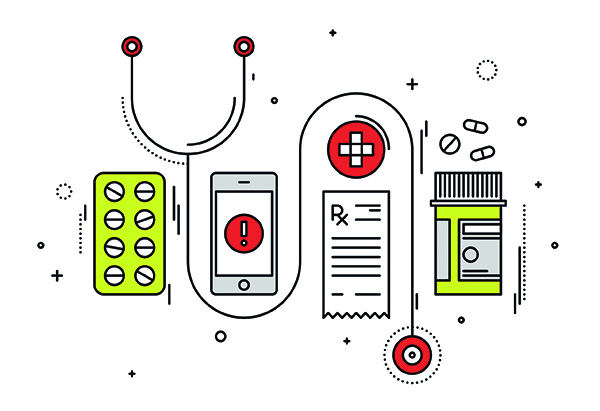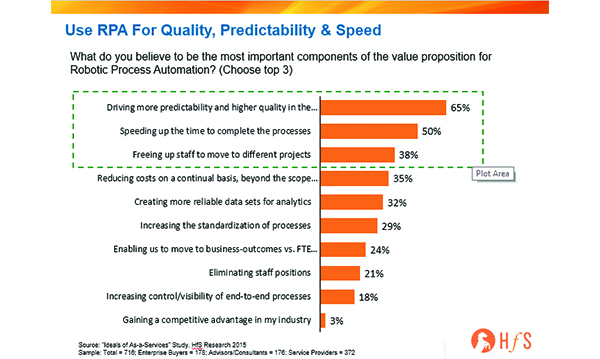
Are you using robotic process automation (RPA) as a way to drive better outcomes for your healthcare organization?
In our research, we are hearing that companies using RPA find the greatest value from it in the quality, predictability, and speed that results from the use of the software to automate rules-driven business processes (there’s your definition of RPA, by the way). And we’d like to hear more examples –stories to share –of how it is being integrated into healthcare operations to impact health, medical and financial outcomes.
Notice in Exhibit 1, that 65% of the respondents in our cross-industry survey say the most value they get from RPA is in driving more predictability and quality in the processes, and half add that speed is of value, while rounding out the top three is freeing up staff to move to other projects. Healthcare respondents mirrored this top three, adding that number four is “creating more reliable datasets for analytics.”
Exhibit 1:

I’d venture to guess that the value of more reliable data sets will increase exponentially as value-based care and reimbursements take center stage in the industry. Predictable, accurate data will be increasingly important in, for example, segmenting patient populations, identifying appropriate and timely care interventions, and capturing and reporting appropriate feedback and insight for reimbursement. Reporting results for reimbursement are absolutely dependent on accurate and timely data.
Where to use RPA in healthcare operations
We heard from one enterprising organization that “every activity, every process is an opportunity for RPA.” Most of the examples we see are in claims processing and coding changes, followed by provider data management where there are many steps that require checking and/or moving data from multiple systems. EXL will share examples of the applicability in care management, for example, on an upcoming webinar, Robotics: A Call To Action In Health Care Management.
But while a number of tasks, activities, and even processes are automated, it is still too often in isolation from a broader process, which can really make an impact. What we have yet to see is dramatic change and impact on the healthcare consumer experience through the use and integration of RPA into a business operation. We’d like to see a significant change to the experience of a healthcare consumer in their patient visit to payment processed, for example, involving RPA, analytics, and customer service.
Think big, and start small—and find your champions. Start where there is the greatest interest in the benefit from the use of it, and the willingness to experiment. It can be anywhere in the operation, really. The key is to identify people who have a passion for using RPA; and in them, you will also find the people who will help drive interest, momentum, business rationale, and results. Results should be about business outcomes, such as reduced fraud or waste, increased medical adherence, reduced readmissions, or better member or patient satisfaction.
In order to get people excited about the prospect of these potential results, it’s important to develop a story around RPA for your internal stakeholders. At a recent HfS Summit discussion with operations leaders, Lee Coulter, Senior Vice President at Ascension and Chief Executive of the Shared Services Subsidiary said that what worked for them was to build a 10 second message, a 30 second speech, and a three-minute story that should include a demo or video clip to “show” how it works. Focus on the impact and results that RPA can drive—the accuracy, speed, and predictability, for example.
Partnering for results
Service provider partners can play a strategic role in identifying opportunities to better leverage RPA. While they are at different stages of maturity, they have been developing capabilities and tools over the past few years on the processes they manage. The use of automation is becoming increasingly sophisticated, especially when you as a service buyer partner with an operations service provider to use RPA in a shared strategy. You’ll find a snapshot of how service providers and service buyers are incorporating automation into their operating models and infrastructures in my recently published POV, Getting the Ball Rolling with RPA in Healthcare Operations.
What’s your greatest challenge, success story, or tip to share?
Just with any change, it takes learning and collaboration to create something meaningful. We look forward to your questions, comments, examples, and stories over the coming months as we figure out how as an industry, healthcare can better leverage RPA to drive better health, medical, and administrative outcomes over time.
Posted in : Robotic Process Automation






Interesting topic to follow.
Wondering where the POV (Getting the ball rolling…) can be found? Link directs to blog archives and search turns in an empty page.
Hi MJ, Here’s a link to the POV: http://www.hfsresearch.com/pointsofview/getting-the-ball-rolling-with-rpa-in-healthcare-operations. We’ve also fixed the link in the article. Thanks!